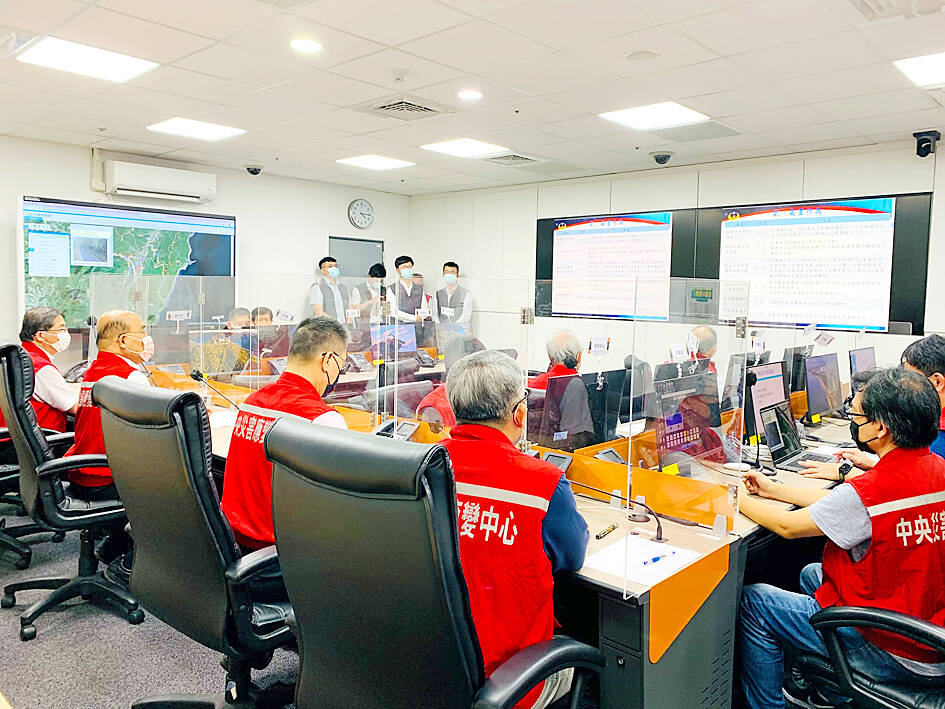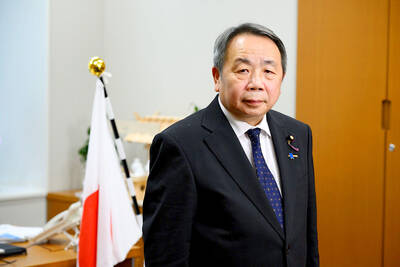People should be prepared for further damage caused by aftershocks following a magnitude 6.8 earthquake at 2:44pm yesterday, although its aftershocks are expected to be of smaller magnitude and occur less frequently than yesterday’s quakes, the Central Weather Bureau (CWB) said yesterday.
Bureau data showed that the quake’s epicenter was 42.7km north of Taitung County Hall at a depth of 7km, which is within Taitung’s Chihshang Township (池上).
The magnitude 6.8 quake, the strongest recorded this year, occurred as the nation was recovering from damage caused by a magnitude 6.4 temblor on Saturday night, with its epicenter in Guanshan Township (關山).

Photo provided by the Executive Yuan
That quake was one of the 73 foreshocks of yesterday’s earthquake, CWB Seismological Center Director Chen Kuo-chang (陳國昌) told reporters.
Yesterday’s quake is also the eighth with a magnitude exceeding 6 this year, Chen said, adding that it could be ranked the sixth or seventh-largest earthquake in Taiwan’s seismic history, following the 921 Earthquake in 1999 and the large aftershocks that followed.
Although few earthquakes have occurred in the past 50 years near the epicenters of this weekend’s quakes, they originated from the inner part of where the Philippine Sea Plate and the Eurasian Plate touch, Chen said.
Compared with the outer side, which is off the coast of Taitung’s Chenggong Township (成功), the inner side has a more rigid rock formation, where earthquakes happen less frequently, he said.
The seismic energy that has accumulated on the inner side of the plates’ meeting point over the past five decades was first released through the magnitude 6.4 earthquake on Saturday, which has likely been balanced by the main earthquake yesterday.
“We cannot predict the occurrences of earthquakes. Theoretically, however, the aftershocks should be of smaller magnitude compared to that of the main earthquake. I estimate that aftershocks are not likely to occur as frequently as the foreshocks. The number of aftershocks exceeding magnitude 5 will also be fewer than the foreshocks,” Chen said.
An aftershock of magnitude 5.4 occurred shortly after yesterday’s earthquake, he added.
A similar situation occurred in 2018, when a magnitude 6.32 earthquake on the Milun Fault triggered an aftershock of magnitude 5.92, he said.
“The Milun Fault is a geologically fragmented zone, and the seismic activities on the zone generated activities in other geological zones from the north to south, as well as from land to sea. The aftershocks lasted about a month, with the number reaching 30 per hour, or three to four per day,” he said, adding that the frequency of aftershocks from this weekend’s quake would not reach that number.
The public warning system for natural disasters functioned normally yesterday, with residents in eight cities and counties south of Chiayi County receiving warnings 10 seconds before the main earthquake, Chen said.
President Tsai Ing-wen (蔡英文) urged people to be vigilant for further aftershocks in the coming hours.
“Water and electricity supplies in some areas have also been affected by the earthquake,” she wrote on Facebook. “The related disaster relief work is in full swing.”
Additional reporting by AFP

A strong continental cold air mass is to bring pollutants to Taiwan from tomorrow, the Ministry of Environment said today, as it issued an “orange” air quality alert for most of the country. All of Taiwan except for Hualien and Taitung counties is to be under an “orange” air quality alert tomorrow, indicating air quality that is unhealthy for sensitive groups. In China, areas from Shandong to Shanghai have been enveloped in haze since Saturday, the ministry said in a news release. Yesterday, hourly concentrations of PM2.5 in these areas ranged from 65 to 160 micrograms per cubic meter (mg/m³), and pollutants were

Taiwan’s armed forces have established response protocols for a wide range of sudden contingencies, including the “Wan Chun Plan” to protect the head of state, the Ministry of Defense (MND) said today. After US President Donald Trump on Saturday launched a series of airstrikes in Venezuela and kidnapped Venezuelan President Nicolas Maduro, concerns have been raised as to whether China would launch a similar “decapitation strike” on Taiwan. The armed forces regularly coordinate with relevant agencies and practice drills to ensure preparedness for a wide range of scenarios, Vice Minister of National Defense Hsu Szu-chien (徐斯儉) told reporters before a

EVA Airways on Saturday said that it had suspended a pilot and opened an investigation after he allegedly lost his temper and punched the first officer several times as their plane was taxiing before takeoff at Los Angeles International Airport. According to a report published on Thursday by The Reporter, the incident occurred after the flight’s Malaysian first officer tried to warn the Taiwanese pilot, surnamed Wen (文), that he was taxiing faster than the speed limit of 30 knots (55.6kph). After alerting the pilot several times without response, the first officer manually applied the brakes in accordance with standard operating

Japanese Councilor Hei Seki (石平) on Wednesday said that he plans to visit Taiwan, saying that would “prove that Taiwan is an independent country and does not belong to China.” Seki, a member of the Japan Innovation Party, was born in Chengdu in China’s Sichuan Province and became a naturalized Japanese in 2007. He was elected to the House of Concilors last year. His views on the Chinese Communist Party (CCP) — espoused in a series of books on politics and history — prompted Beijing to sanction him, including barring Seki from traveling to China. Seki wrote on X that he intends